Topics List
Jun. 25, 2009 Updated
LNG flight engine firing test
|
A series of firing tests using the Liquid Natural Gas (LNG) rocket flight engine is being carried out from June 22, 2009, at the IHI Headquarters Representative's Office in Aioi District (Hyogo, Japan,) to verify the design validity. |
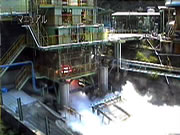
|
|---|
Sep. 1, 2008 Updated
Unit combustion test result of the LNG engine gas generator
Between August 20 and 29, 2008, nine unit combustion tests on the gas generator were carried out for the liquid natural gas engine (LNG engine.)
The performance was confirmed to be normal in the all tests, and technical data was successfully acquired.
Nov. 5, 2004 Updated
Tank Material Characteristic Test and One-fifth Scaled Engine Firing Test
The LNG project team carried out the following tests between June and September 2004.
|
<Composite Cryogenic Propellant Tank/Material Characteristic Test> |
 |
|---|
|
<LNG Igniter/Unit Test> |
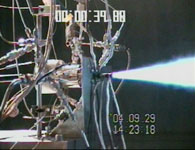 |
|---|
|
<Subscale LNG Engine/Firing Test> |
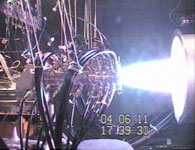 |
|---|
Jul. 2, 2004 Updated
The LNG Propulsion Project Team carries out basic studies and provides technology development for the LNG (liquid natural gas) propulsion system (a comprehensive propulsion system including an engine).
|
A launch vehicle with LNG as its propellant is expected to be a high performance vehicle with low costs, but nobody in the world has successfully implemented its practical use. Therefore, it is very important to acquire basic data and steadily accumulate enabling technologies. (1) Together with the Tokyo Metropolitan Institute of Technology we studied LNG/oxygen ignition characteristics. The study aimed to acquire basic data on ignition, and we performed 475 ignition tests in total under different conditions. We were able to acquire ignition characteristics data on premixed methane and oxygen gas under pressure lower than 0.2. This had previously been an unexplored area for which we could not find data, even in overseas academic documents. The data will be useful for designing an igniter. We continue to acquire the necessary data for designing this in JFY 2004 by making the combustion condition visible inside the actual igniter. |
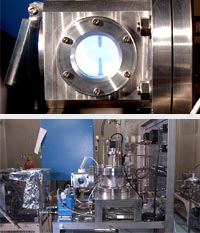 |
|---|
Jun. 14, 2004 Updated
Abnormal combustion during LNG Sub-scale Engine Test
Time: around 5:40 p.m. on June 11 (Friday), 2004
Location: JAXA's Kakuda Space Propulsion Center (KSPC) (in Miyagi Pref.)
During a firing test on the LNG one-fifth, sub-scale engine for research at the KSPC, an abnormal pressure increase occurred at the time of cutoff after the planned 10 second combustion. Combustion gas leaked just after the pressure increase, but it extinguished itself in about 16 seconds.
JAXA is now checking the situation and carrying out an investigation.
Apr. 2, 2003 Updated
Studies on LNG Propulsion System "Composite Cryogenic Tanks" and Structure
|
In Japanese Fiscal Year (JFY) 2003, a full-scaled model of an LNG (liquid natural gas) composite cryogenic tank was tested both in normal temperature and cryogenic condition. The objective of the tests was to acquire data concerning structure, such as distortion and displacement data, under the environment of changing temperature and pressure to incorporate them into the design of the flight model. The objective was mostly fulfilled as planned. |
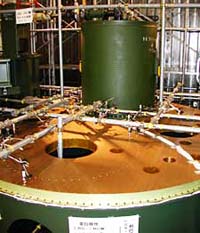 |
|---|
|
LNG engine BFT (Battleship Firing Test) |
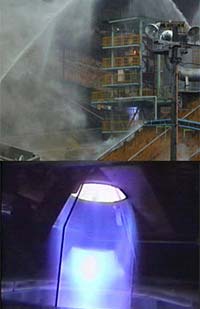 |
|---|
Dec. 2, 2002 Updated
FST#1 Ambient Temperature Strength and Rigidity Test
|
Anambient temperature strength and rigidity test on the cryogenic composite tank for liquefied natural gas (LNG) was conducted in May, fiscal year 2002. The main purpose of this test was to obtain rigidity data on a full-scale model at normal temperatures in order to reflect it in the actual tank design. The test was conducted as planned. A low temperature strength and rigidity test on the cryogenic composite tank for LNG and ambient and low temperature strength and rigidity tests on the cryogenic composite tank for liquid oxygen (LOX) are also scheduled in 2002 (FY.) |
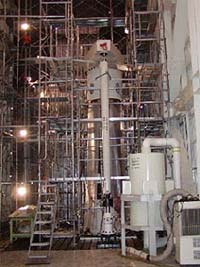 |
|---|
Dec. 2, 2002 Updated
Mission Duty Cycle Firing Demonstration on Liquefied Natural Gas (LNG) Engine
|
The mission duty cycle (MDC: 353[sec]) firing demonstration on the LNG engine was conducted in 2001 fiscal year to acquire the performance data during the assumed time period of actual flight and to also confirm the durability of this component. Both the performance data and the durability were preferable. The Battleship Firing Tests (BFT) on the LNG engine are scheduled for 2002 (FY). |
 |
|---|